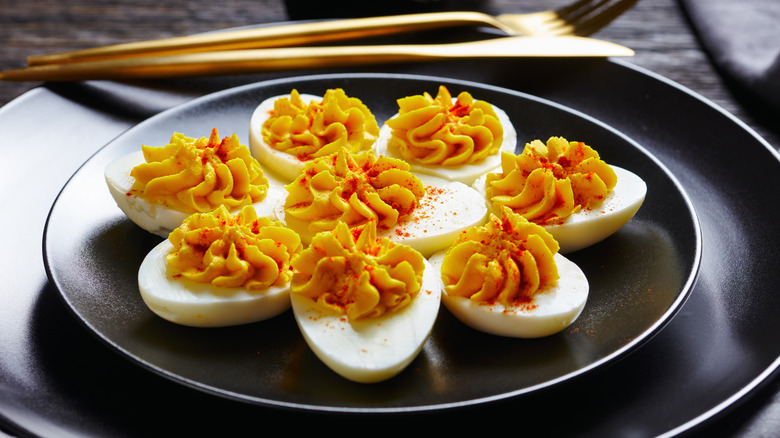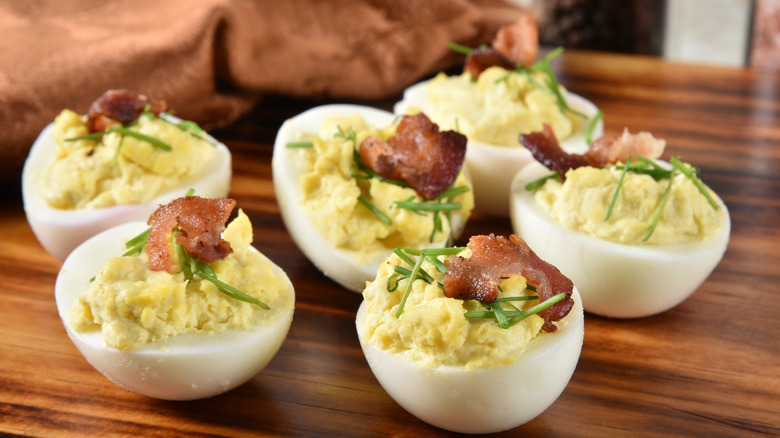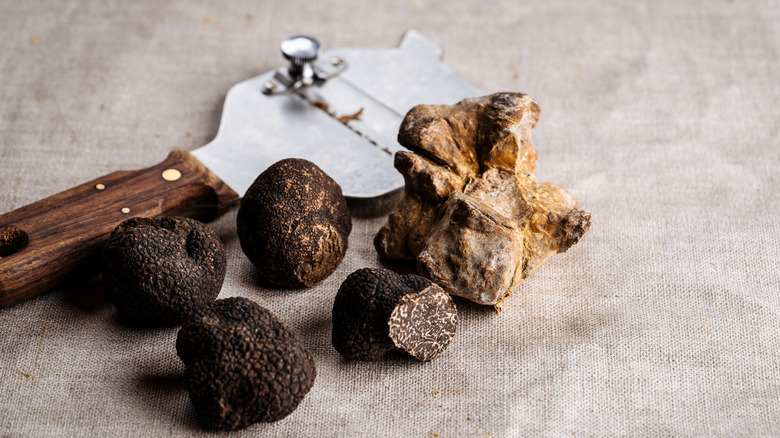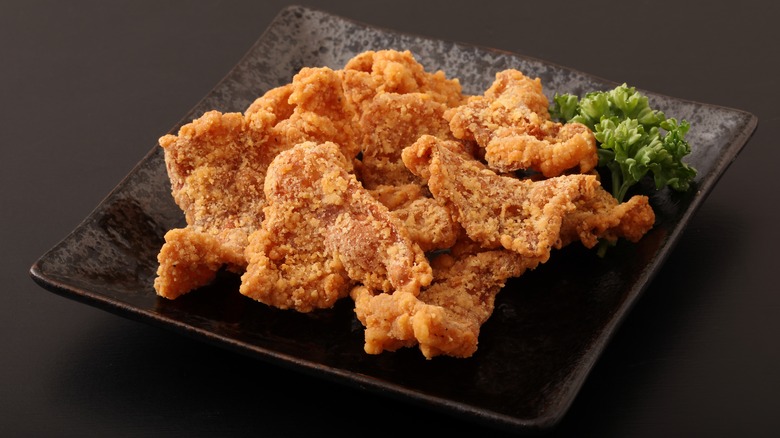How Bacon Bits Can Take Your Deviled Eggs To The Next Level
We may receive a commission on purchases made from links.
Deviled eggs, aka hard-boiled eggs with the yolks mashed into a creamy paste, are a common selection amid any spread of finger foods and snacks at a party. As Alto-Harley explains, deviled eggs go as far back as ancient Rome, where eggs were boiled and served with spicy sauces at the beginning of a meal. The practice of serving what would later be known as deviled eggs spread to Spain and then medieval Europe before making its first "modern" appearance in the late 19th century. A popular, time-tested appetizer, deviled eggs are inexpensive and easy to make.
But as with all dishes, deviled eggs can be prone to simple mistakes. These mistakes range from overcooking the eggs to creating flavorless, lumpy yolk mixtures, notes HuffPost. Fortunately, deviled eggs that turn out less than stellar can be fixed with toppings. Depending on your taste, deviled eggs can be smokey, savory, hot, or even fried (as The Neelys suggest).
A good addition is bacon — or more specifically, bacon bits. While bacon is known for making just about anything somewhat edible, what makes it such a good choice for deviled eggs in particular?
Bacon bits add texture and flavor
With most deviled eggs, you expect them to be relatively smooth, from the tender egg to the creamy yolk filling. A good topping provides extra flavor and some much-needed texture. That's where bacon bits come in.
As Real Simple explains, the addition of bacon bits (homemade or store-bought) provides a smokey flavor and crispy texture to the otherwise smooth and neutral-flavored eggs. To amplify the bacon flavor, James Beard suggests using fried pork belly in lieu of bacon, which will give it a much bolder texture. One can also make Chef Derrell Smith's loaded deviled eggs, which include black-eyed peas and pork chops for a meatier, complex flavor.
Other ways you can add textures and flavors to your eggs can include lobster (courtesy of Michele Ragussis), Chick-fil-A sauce (per The Deviled Egg Company), and even potato chips, if you're following Emeril Lagasse's deviled eggs recipe. As long as you have a lot of eggs, the sky's the limit.
You can also use truffles — if you can
Truffles aren't as common as your average pack of bacon. They're more of a delicacy; a single jar of black truffles can cost as much as $30 on Amazon . But should you have an event coming up where you want your deviled eggs to stand out, adding a bit of truffle may not be a bad idea.
Anne Burrell's deviled eggs recipe details how to use truffles in deviled eggs, using both the oil and truffle itself. (For a $30 ingredient, you're going to want the most for your money, right?) Burrell's recipe includes mixing the yolks of a hard-boiled egg, mayonnaise, truffle oil, and cayenne into a creamy filling before piping into the egg whites and topping off with chopped truffles and chives. Epicurious takes the recipe one step farther, suggesting that you use "black lava salt" and 24-karat gold leaf as a garnish; these aren't your grandmother's deviled eggs.
While truffles aren't as easy to find as bacon, their addition of truffles adds a rich flavor to a typically common, simple dish.
Try Southern-fried chicken skin for an extra crunch
When you think of chicken skin, you likely think of greasy, somewhat soggy, and chewy brown skin that gets in the way of all that juicy, tender meat. While that may be true, chicken skin can also be a flavorful, crisp garnish for deviled eggs.
As The Local Palate details, preparing fried chicken skin isn't too complex. All you need to do is remove the skin from the bird, making sure that you remove as much fat as you can from the skin while you do so. Place the skins in a pot with water, onion, garlic, and bay leaves, and boil the water until at medium-high heat before killing the heat and letting them sit for 15 minutes. Next, drain and dry the skins while preparing your fry coating of flour, cornmeal, breadcrumbs and seasonings. Once the chicken skins are cool, dredge them in the fry coating and fry them up.
If you're worried about the taste of chicken skin, Esquire describes it as being similar to bacon in terms of "mouthfeel." And it's been a part of Jewish cooking for many years. Consider it a crispier version of fried chicken that will provide a salty, crunchy, and Southern-style flavor to your deviled eggs.



